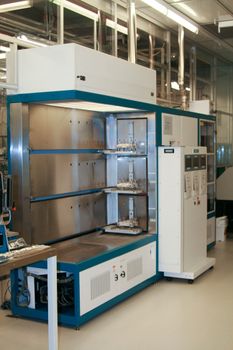Tube Furnace (Tystar 8300): Difference between revisions
→Recipes: link to recipes page |
|||
| Line 46: | Line 46: | ||
* DRYVAR.003 - ''DryOx, variable temp.'' |
* DRYVAR.003 - ''DryOx, variable temp.'' |
||
* ANNEAL.003 - ''Anneal with variable time and temperature'' |
* ANNEAL.003 - ''Anneal with variable time and temperature'' |
||
=== [[Thermal Processing Recipes#Tystar 8300|<u>Oxidation Rates & Data</u>]] === |
|||
''See the above recipes page for data on oxidation rates for standard oxidation recipes.'' |
|||
=Useful Information= |
=Useful Information= |
||
[ |
[//wiki.nanotech.ucsb.edu/w/images/8/89/TystarMechDrawWaferBoat.pdf Tystar Wafer Boat Drawing - 4" Wafer with 0.5mm Slots] |
||
=See Also= |
=See Also= |
||
| Line 57: | Line 60: | ||
=Operational Instructions= |
=Operational Instructions= |
||
*[ |
*[//wiki.nanotech.ucsb.edu/w/images/8/8a/Tystar_Operational_Procedure.pdf Operating Instructions] |
||
Revision as of 01:08, 2 February 2021
|
About
The three stack Tystar 8” furnace is used primarily for 3 processes. The processes are dedicated for specific tubes as follows:
- Tube #1: SOG curing & low-temp oxidation
- Tubes #2 and #3: Dry or wet oxidation of silicon (unprocessed, clean)
- Tube #3: General furnace annealing & oxidation, including processed material
Each process tube can accomodate up to one hundred 8” wafers per cycle. We have boats for 2", 3", 4", 6", 8" and irregular shaped pieces. The maximum temperature is 1100°C for the system. Gases used are O2, Steam from DI-H2O, N2.
Process Information
Recipe Characterization Data, such as thermal oxidation times, can be found on the recipe page:
Use the BYU or Stanford Leland Jr. Thermal Oxidation Calculators to determine the time and temperature that will be necessary for your process needs. You can "calibrate" your oxidations to the Stanford calculator by adjusting the Partial Pressure on the calculator to match your experimental data.
Keep in mind that all process must be 30 minutes in length at a minimum. Processes less than 30 minutes will suffer from poor uniformity because the process tube will not have sufficient time to saturate with O2 or DI-H2O.
Recipes
The following are the available recipes on each furnace tube:
Tube 1:
- SOG425.001 - Spin-On Glass Cure
- ALGAAS.001 - Oxidation of AlGaAs
Tube 2:
- WET1050.002 - WetOx at 1050°C
- DRY1050.002 - DryOx at 1050°C
- WETVAR.002 - WetOx, variable temp.
- DRYVAR.002 - DryOx, variable temp.
Tube 3:
- WET1050.003 - WetOx at 1050°C
- DRY1050.003 - DryOx at 1050°C
- WETVAR.003 - WetOx, variable temp.
- DRYVAR.003 - DryOx, variable temp.
- ANNEAL.003 - Anneal with variable time and temperature
Oxidation Rates & Data
See the above recipes page for data on oxidation rates for standard oxidation recipes.
Useful Information
Tystar Wafer Boat Drawing - 4" Wafer with 0.5mm Slots
See Also
- Tystar - Manufacturer of the tool
- Silicon Thermal Oxide Thickness Calculator (BYU) - Use this on-line calculator to calculate times for silicon oxidation.
- Advanced Silicon Thermal Oxide Thickness Calculator (Stanford Leland Jr.) - Another thermal oxide calculator, with flexibility to vary partial pressure parameter to calibrate to your own process.
